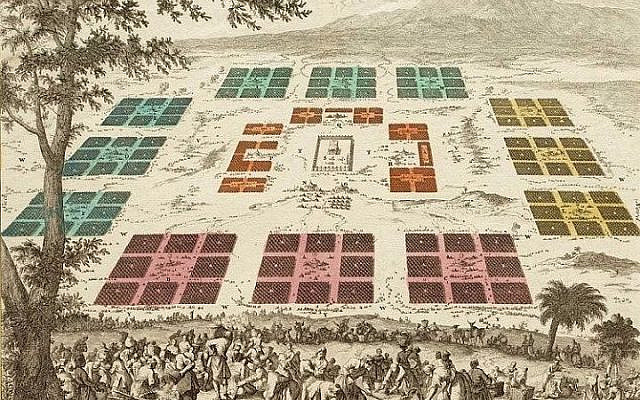Discover how the Israelite encampment reveals profound insights about the Church’s mission and unity in God’s divine plan.
Exploring the Israelite encampment around the Tabernacle, we delve into the divine instructions that ordered the tribes during their wilderness journey. This arrangement, described in the book of Numbers, is not merely a historical account but also a profound symbol of order, unity, and centrality of worship, prefiguring the Church’s mission in the New Testament.
The Arrangement of Israelite Tribes Around the Tabernacle
One of the fascinating aspects of the Israelites’ journey through the wilderness is the meticulous way God instructed them to organize their encampment and travel arrangements. This divine guidance ensured order and centrality of worship, which is essential for understanding ancient Israel’s cultural and religious dynamics.
Divine Instructions for Tribal Arrangement
The instructions for arranging the Israelite tribes around the Tabernacle are in the Book of Numbers, chapter 2. God spoke to Moses and Aaron, commanding them how each tribe should position itself with the Tabernacle. This arrangement wasn’t just a random setup but a divinely orchestrated plan.
Numbers 2:1-2 (KJV) states: *”And the Lord spake unto Moses and unto Aaron, saying, Every man of the children of Israel shall pitch by his own standard, with the ensign of their father’s house: far off about the tabernacle of the congregation shall they pitch.”*¹
In these verses, “standard” refers to the tribal banners or flags representing the twelve tribes. The phrase “far off about the tabernacle” indicates that while they were to be near the Tabernacle, there was to be a respectful distance, emphasizing the sacredness of the Tabernacle.
Specific Positions of the Tribes
The chapter continues to outline the specific locations for each tribe:
- East side: Judah, Issachar, and Zebulun (Numbers 2:3-9)
- South side: Reuben, Simeon, and Gad (Numbers 2:10-16)
- West side: Ephraim, Manasseh, and Benjamin (Numbers 2:18-24)
- North side: Dan, Asher, and Naphtali (Numbers 2:25-31)
- Center: The Levites around the Tabernacle (Numbers 2:17, 33)
This formation provided a systematic way to set up camp and symbolized unity and organization, with the Tabernacle—the dwelling place of God’s presence—at the center.
Application: While Stationary and Traveling
The arrangement described in Numbers 2 was not limited to when the Israelites were stationary. It also dictated how they moved during their journey through the wilderness. When camped, each tribe had its designated position around the Tabernacle, ensuring a central place of worship and a clear order. This is evident from the initial instructions:
*”Every man of the children of Israel shall pitch by his standard, with the ensign of their father’s house: far off about the tabernacle of the congregation shall they pitch.”*²
When it was time to move, the tribes would break camp and proceed in a specific sequence, maintaining the same formation. This is described in Numbers 2:34:
*”And the children of Israel did according to all that the Lord commanded Moses: so they pitched by their standards, and so they set forward, every one after their families, according to the house of their fathers.”*³
The arrangement of the Israelite tribes around the Tabernacle, as commanded by God, exemplifies divine order and the importance of centralizing worship in the community. This structured approach, detailed in Numbers 2, highlights the spiritual and practical aspects of the Israelites’ journey through the wilderness. Understanding these arrangements provides deeper insights into ancient Israel’s cultural and religious life.
Transitioning from this detailed examination of Israel’s physical organization and journey, we find deeper spiritual meanings that bridge the Old and New Testaments. This encampment, reflecting unity and divine presence, is a symbolic precursor to the Church’s mission, which carries the Gospel worldwide. This typological connection enriches our understanding of God’s redemptive plan throughout history.
Israelite Encampment and the Church: Types and Shadows
The arrangement of the Israelite tribes around the Tabernacle, as detailed in Numbers 2, is not just a historical account but also a profound “type and shadow” of the Church. In biblical typology, a type is a person, event, or institution in the Old Testament that prefigures a corresponding reality (the antitype) in the New Testament. The orderly encampment and movement of Israel in the wilderness foreshadow the mission and structure of the Church, which is called to carry the Gospel (the cross) throughout the world (the wilderness).
Israel’s Camp: A Divine Blueprint
In Numbers 2, God gave specific instructions on how the twelve tribes of Israel were to camp around the Tabernacle. Each tribe had a designated position, ensuring that the Tabernacle, representing God’s presence, remained central. This arrangement signified order, unity, and the primacy of worship.
Numbers 2:1-2 (KJV) states: *”And the Lord spake unto Moses and unto Aaron, saying, Every man of the children of Israel shall pitch by his own standard, with the ensign of their father’s house: far off about the tabernacle of the congregation shall they pitch.”*⁴
This precise organization reflects God’s desire for His people to be centered around His presence, highlighting the importance of communal worship and adherence to divine order.
The Church: A New Testament Parallel
The New Testament Church is often seen as the antitype of Old Testament Israel. Just as Israel was organized around the Tabernacle, the Church is centered on Christ and His Gospel. The Apostle Paul emphasizes the unity and collective mission of the Church in his epistles:
Ephesians 4:15-16 (KJV): *”But speaking the truth in love, may grow up into him in all things, which is the head, even Christ: From whom the whole body fitly joined together and compacted by that which every joint supplieth, according to the effectual working in the measure of every part, maketh increase of the body unto the edifying of itself in love.”*⁵
This imagery of the Church as a body, with Christ as the head, echoes the orderly and purposeful arrangement of the Israelite tribes.
Carrying the Gospel in the Wilderness
Just as the Israelites journeyed through the wilderness with the Tabernacle at their center, the Church is called to carry the Gospel worldwide. This mission is encapsulated in the Great Commission:
Matthew 28:19-20 (KJV): *”Go ye therefore, and teach all nations, baptizing them in the name of the Father, and of the Son, and of the Holy Ghost: Teaching them to observe all things whatsoever I have commanded you: and, lo, I am with you alway, even unto the end of the world.”*⁶
The Church’s journey through the world’s “wilderness” involves spreading the Gospel, much like the Israelites carried the symbols of God’s presence and promises through their journey.
Types and Shadows: Insights from Commentary
Biblical scholars and theologians have long noted the typological connections between Israel and the Church. In his commentary on Numbers 2, Matthew Henry observes that the order and discipline of Israel’s camp prefigure the organized and purposeful nature of the Church⁷. The Church, like Israel, must remain united and centered on God’s presence, which is embodied in Christ and the Gospel for Christians.
Conclusion
The arrangement of the Israelite tribes around the Tabernacle serves as a rich typological foreshadowing of the Church. This divine blueprint underscores the importance of unity, order, and centrality of worship. As the Church journeys through the world’s wilderness, it carries the Gospel, fulfilling the Great Commission and living out the shadowed realities seen in the Old Testament. Understanding these connections enriches our appreciation of biblical continuity and God’s redemptive plan throughout history.
References
- The Holy Bible, King James Version. Numbers 2:1-2.
- The Holy Bible, King James Version. Numbers 2:2.
- The Holy Bible, King James Version. Numbers 2:34.
- The Holy Bible, King James Version. Numbers 2:1-2.
- The Holy Bible, King James Version. Ephesians 4:15-16.
- The Holy Bible, King James Version. Matthew 28:19-20.
- Henry, Matthew. Commentary on the Whole Bible. Hendrickson Publishers, 1991.





